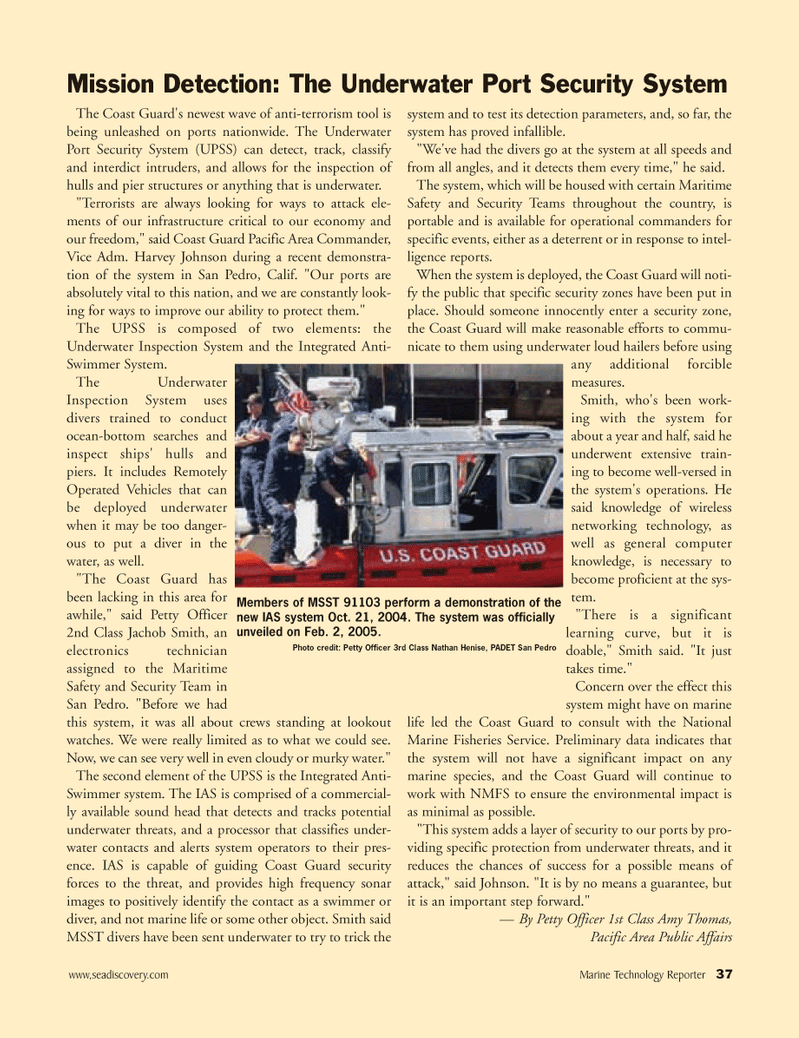
Page 37: of Marine Technology Magazine (September 2005)
Maritime Security & Undersea Defense
Read this page in Pdf, Flash or Html5 edition of September 2005 Marine Technology Magazine
The Coast Guard's newest wave of anti-terrorism tool is being unleashed on ports nationwide. The Underwater
Port Security System (UPSS) can detect, track, classify and interdict intruders, and allows for the inspection of hulls and pier structures or anything that is underwater. "Terrorists are always looking for ways to attack ele- ments of our infrastructure critical to our economy and our freedom," said Coast Guard Pacific Area Commander,
Vice Adm. Harvey Johnson during a recent demonstra- tion of the system in San Pedro, Calif. "Our ports are absolutely vital to this nation, and we are constantly look- ing for ways to improve our ability to protect them."
The UPSS is composed of two elements: the
Underwater Inspection System and the Integrated Anti-
Swimmer System.
The Underwater
Inspection System uses divers trained to conduct ocean-bottom searches and inspect ships' hulls and piers. It includes Remotely
Operated Vehicles that can be deployed underwater when it may be too danger- ous to put a diver in the water, as well. "The Coast Guard has been lacking in this area for awhile," said Petty Officer 2nd Class Jachob Smith, an electronics technician assigned to the Maritime
Safety and Security Team in
San Pedro. "Before we had this system, it was all about crews standing at lookout watches. We were really limited as to what we could see.
Now, we can see very well in even cloudy or murky water."
The second element of the UPSS is the Integrated Anti-
Swimmer system. The IAS is comprised of a commercial- ly available sound head that detects and tracks potential underwater threats, and a processor that classifies under- water contacts and alerts system operators to their pres- ence. IAS is capable of guiding Coast Guard security forces to the threat, and provides high frequency sonar images to positively identify the contact as a swimmer or diver, and not marine life or some other object. Smith said
MSST divers have been sent underwater to try to trick the system and to test its detection parameters, and, so far, the system has proved infallible. "We've had the divers go at the system at all speeds and from all angles, and it detects them every time," he said.
The system, which will be housed with certain Maritime
Safety and Security Teams throughout the country, is portable and is available for operational commanders for specific events, either as a deterrent or in response to intel- ligence reports.
When the system is deployed, the Coast Guard will noti- fy the public that specific security zones have been put in place. Should someone innocently enter a security zone, the Coast Guard will make reasonable efforts to commu- nicate to them using underwater loud hailers before using any additional forcible measures.
Smith, who's been work- ing with the system for about a year and half, said he underwent extensive train- ing to become well-versed in the system's operations. He said knowledge of wireless networking technology, as well as general computer knowledge, is necessary to become proficient at the sys- tem. "There is a significant learning curve, but it is doable," Smith said. "It just takes time."
Concern over the effect this system might have on marine life led the Coast Guard to consult with the National
Marine Fisheries Service. Preliminary data indicates that the system will not have a significant impact on any marine species, and the Coast Guard will continue to work with NMFS to ensure the environmental impact is as minimal as possible. "This system adds a layer of security to our ports by pro- viding specific protection from underwater threats, and it reduces the chances of success for a possible means of attack," said Johnson. "It is by no means a guarantee, but it is an important step forward." — By Petty Officer 1st Class Amy Thomas,
Pacific Area Public Affairs www,seadiscovery.com Marine Technology Reporter 37
Mission Detection: The Underwater Port Security System
Members of MSST 91103 perform a demonstration of the new IAS system Oct. 21, 2004. The system was officially unveiled on Feb. 2, 2005.
Photo credit: Petty Officer 3rd Class Nathan Henise, PADET San Pedro
MTR#2 (33-48).qxd 8/30/2005 5:27 PM Page 37

 36
36

 38
38
